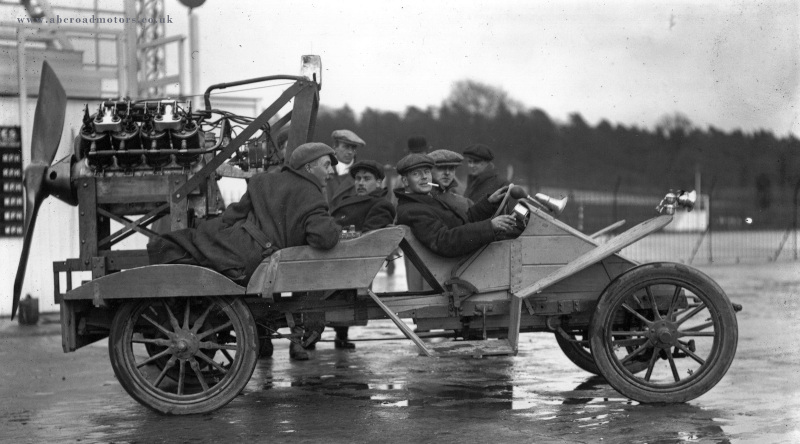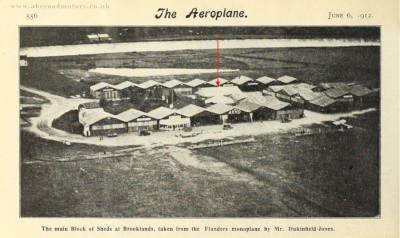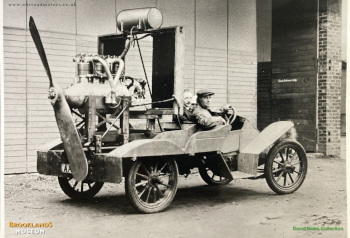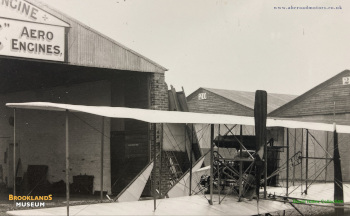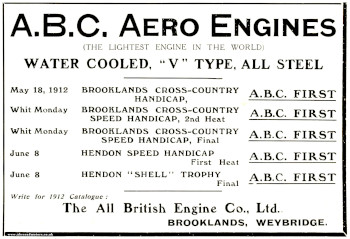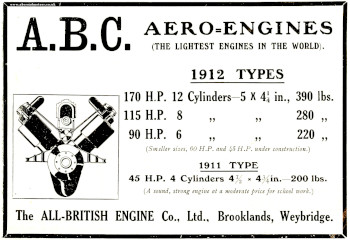TO MOST PEOPLE, A.B.C. will conjure up a picture of the local cinema, a child's alphabet book, or a rail guide. To those interested in Veteran and Vintage vehicles the choice might be a motorcycle with laminated spring frame, a light car, and the tiny Skootamota. In fact, the range of products was somewhat larger.
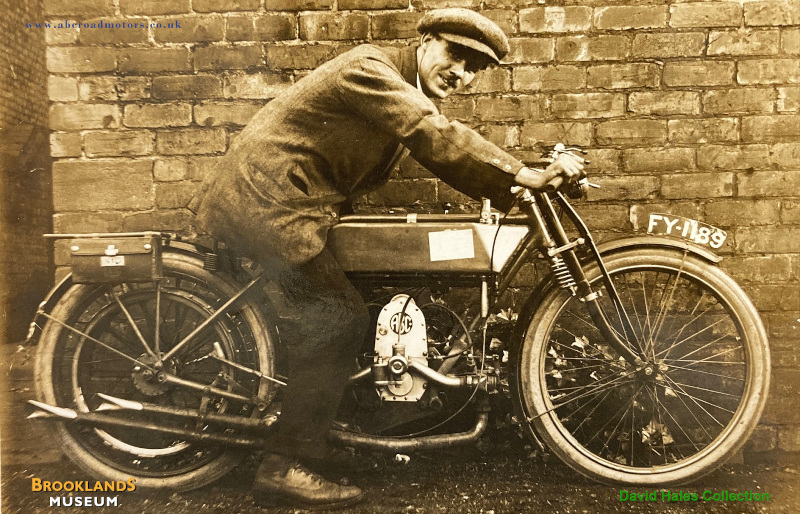
Jack Falahee on Alfred Wray’s 1913 A.B.C.-engined TT motorcycle - Curtesy of Brooklands Museum, David Hales Collection.
From about the turn of the century, a small workshop (Redbridge Motor Works) in Redbridge, near Southampton, under the name of Walter Lawson Adams - motor engineer, designed and installed engines for small motorboats and hydroplanes. A 10-12hp engine installed in a boat named `Bluebottle" in 1904, won its class in some reliability trials in 1905 in the Southampton area whilst a 15hp V-twin was fitted to a hydroplane in 1909. By that time, he had become more interested in aircraft engines and, to pursue such interests, he first formed the Aeroplane Engine Company and then joined forces with Ronald Louis Charteris.
Charteris was the grandson of the 7th Earl of Wemyss and March and, after having served as a Second Lieutenant in the King's Own Royal Regiment Norfolk, he showed interest in aviation. Based on a record from his sister, sometime between 1908 and 1910 he went to France to learn to fly and, at his return, he got involved in organising the 1910 International Air Show week at Bournemouth. That’s possibly where he met Adams and the two of them soon got into business together creating the W.L. Aero Engine Company on the 10th of August 1910. Adams was the Managing Director and provided the Works while Charteris arranged the funding by involving his uncle Ernest Noel and several businessmen from the Bournemouth area. It's not clear if the company aimed at selling new engines designed by Adams or selling engines produced by the Aeroplane Engine Company but not much ever came out of it. Adams probably had different plans in mind and kept on privately advertising as a Consulting Engineer & Technical Expert but no record has been found of any design ever produced under the W.L. Aero Engine name.
Charteris however kept in touch with his friends at the Brooklands Flying Ground and towards the beginning of December 1910 he must have noticed a new young guy moving around the Brooklands fields. His name was Granville Bradshaw and had been sent by the Star Aeroplane Company to sell their monoplane.
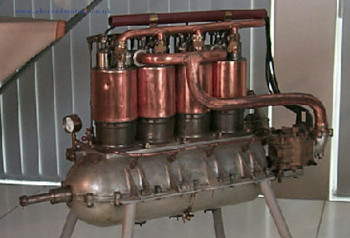
The first engine designed by Bradshaw in 1910. The Star water-cooled four. - Courtesy of Royal Air Force Museum.
Bradshaw was then a 23-year-old engineer who was hired by the Star Aeroplane Company of Wolverhampton to develop a monoplane based on his own design.
The first version of this aeroplane was presented at Olympia in early 1910. Initially fitted with a standard Star car engine, it received moderate interest by the press of the time. Later in the same year, a more powerful 40hp Star water-cooled four-cylinder was designed specifically for the monoplane and Bradshaw managed to test his creation by taking off at Dunstall Park, Wolverhampton and flying for several short flights. Around the same time, Star was also working on a biplane with an 80hp V8 engine but Joe Lisle, owner of the controlling company (Star Engineering Co.) realised how dangerous aviation could be. Having witnessed his son’s attempts at taking off with the Star monoplane, towards the end of 1910 he decided to cut funding and close the Star Aeroplane Company as soon as possible.
Bradshaw, main designer and pilot for the Star monoplane, was sent to Brooklands to demonstrate the capabilities of his machine and on the 12th of December he took to the air managing a few straight flights before stopping due to strong winds. Taking the risk of crashing was certainly not advisable but he must have attracted Charteris attention who likely arranged for two experienced pilots to test the monoplane: James Valentine and Robert Macfie. Around the turn of the year they had several runs on the Star likely spotting some value in the engine but finding the monoplane quite disappointing and not worth an investment. Around the same time (7th January 1911) Adams resigned from the W.L. Aero Engine Company and sold all his shares in a hurry, probably outraged by Charteris suggestion to rely on somebody else’s engine design.
In just a couple of months, Charteris took control of the company, replaced his chief designer with Bradshaw and, on the 25th of February 1911, renamed the company to The All British (Engine) Company Limited (also known as A.B.C. – Yes, the dots are included!) but kept his premises at Redbridge.
As part of the deal with Star, A.B.C. must have acquired the rights and prototypes of both the in line four and V8 engines created by Star.
Charteris had great ideas in mind and applied for a stand at the 1911 Olympia Show which opened on the 24th of March.
A.B.C. managed to present an 80hp V8 and part of a 120hp V12 but also reported to the press plans to offer a 40hp inline four on top of the V8 and the V12. Apparently, there was already a buyer for the latter which was intended for the Flanders F1 monoplane in course of construction at Brooklands. The V12 was likely never completed but Charteris and Bradshaw turned up at Brooklands on a cold Saturday morning with the V8 fitted to the back of a car chassis nicknamed the Windbus. This was an old chassis stripped of its engine, gearbox, and transmission with a timber body, of sorts, a forward-facing bench-seat in front and two seats facing backwards at the rear.
The V8 was likely not sufficient to satisfy the requested capacity and the Flanders F1 project was cancelled due to lack of an adequate engine but, nevertheless, it was a start for the young company.
A.B.C. must have aimed at producing some of the most powerful aviation engines of the time but development was slow and, inevitably, several promised deliveries never materialised. The trend only started to change in August 1911 when a new 40hp 4 cylinder was tested at Brooklands. This was part of a new refined line of engines developed from the original Star engine and planned to be sold by the Universal Aviation Co. Ltd.
"Mr. CHARTERIS, of the A.B.C. company, informed us that he had recently been doing an unofficial test of his 40hp engine at Brooklands. The engine was fitted with a propeller which apparently absorbed all the power of a 40hp engine of another make, but the A.B.C. kept it turning at over 1,400rpm for something like 10 hours on end, and after 6 hours’ run was actually turning it 50rpm faster."
The Aeroplane, 21st December 1911, page 693
Charteris must have been confident in the new product but at the same time he must have been conscious that much more development was required and sales would have been limited for quite some time. To solve these problems and still get some much-needed income, in November 1911 he moved the company premises from Redbridge to the heart of the Brooklands Flying Ground where he made his team available “for all kinds of repair work for aeroplanes or cars”.
Development continued during the winter and a new revised lighter versions of the V8 and V12 engines were presented in the Spring of 1912.
Part of the development was once again carried out around the Brooklands track by fitting engines on the Windbus which had been renamed to Wind Wagon. This inevitably attracted the attention of the press and Bradshaw did not miss the opportunity for rising even more visibility by promoting the idea of road vehicles being driven by propellers. The debate went on for some months with readers responses being a mix of amusement, laughter and anger but, nevertheless, Bradshaw knew how any advertisement was good advertisement.
Between February and April, the 1911 40hp engine was successfully tested on different planes (Deperdussin monoplane taxi no.4, Sopwith's Howard-Wright 1910 Type monoplane and finally on an ancient Hanriot belonging to Mr. George England) and Charteris himself, who in the meantime gained his flying certificate, carried out most test flights. This little engine really came to its own when fitted onto the Sopwith-Wright biplane and piloted by Raynham and Perry. Several competitions were won throughout the year but it was Harry George Hawker who brought it to fame by winning the Michelin Cup on the 24th of October 1912 and setting the British duration record.
“FLYING for the British Michelin Cup No. 1 on the 24th ult., at Brooklands on the Sopwith-Wright biplane fitted with a 40-50hp A.B.C. engine, Mr. H. G. Hawker made a non-stop trip of 8 hrs. 23 mins., the flight only being terminated by the gathering darkness. Subject to the confirmation of the Royal Aero Club Committee, this performance secured the Cup to Mr. Hawker for this year as his time was unbeaten when the competition closed on Thursday last. A Bosch magneto was fitted, and the A.B.C. engine ran without a single misfire.”
Flight International 2nd November 1912, page 1005
The success was certainly a major boost for ABC but, more importantly, the 40hp in line four was the first engine which provided some needed income.
Several successes were achieved in competitions and a handful of aviation engines were sold but production was very limited (only two 40hp were ever produced) and most of the time was spent developing new refinements or carrying out ad-hoc engineering requests for Brooklands racers which kept the company going.


